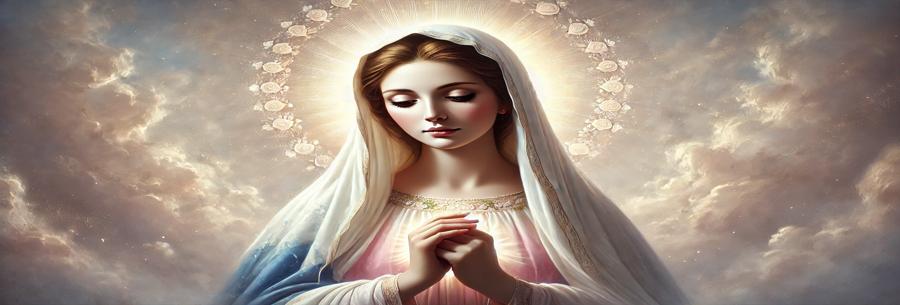Mary, the mother of Jesus Christ, occupies a unique and irreplaceable place in the Christian faith. Revered by millions of believers throughout the ages, she is much more than a biblical figure: she is a spiritual figure, a model of faith and a powerful intercessor. This article explores in depth her central role in Christianity, her theological importance, and her spiritual and cultural impact.
The role of Mary in the Christian faith
Mary, Mother of God (Theotokos):
The title Theotokos (Mother of God), defined at the Council of Ephesus in 431, emphasises Mary's divine maternity. By giving birth to Jesus, both true God and true man, Mary plays a fundamental role in the plan of salvation. This title recalls:
Her direct participation in the incarnation of God: Her unique mission as mother of Jesus, source of grace for humanity.
The Immaculate Conception:
The dogma of the Immaculate Conception, proclaimed in 1854 by Pope Pius IX, affirms that Mary was preserved from original sin from the moment of her conception. This reflects her perfect purity and divine preparation to welcome the Son of God.
Mary, the new Eve:
In Christian theology, Mary is often compared to Eve. While Eve, through her disobedience, introduces sin into the world, Mary, through her total obedience to God, becomes the mother of redemption. This parallel highlights her role in the restoration of humanity.
The Marian apparitions and their spiritual impact
Lourdes and the confirmation of the dogma
In 1858, the Virgin Mary appeared to Bernadette Soubirous at Lourdes, presenting herself as the Immaculate Conception. Since then, Lourdes has become a major place of pilgrimage, where millions of believers come to seek healing and comfort.
Fatima and the call to conversion:
In 1917, at Fatima, Mary appeared to three children and transmitted messages of prayer, penance and conversion. These apparitions reinforce the idea of Mary as mediatrix between God and humanity.
Guadalupe, a universal Mary:
At Guadalupe, in 1531, Mary appeared to a Mexican native, Juan Diego, in the guise of an indigenous woman. This appearance underlines the universality of Mary, who speaks to all peoples and cultures.
Marian titles and symbols
Mary bears many titles that reflect her mission and spiritual role:
Queen of Heaven: She is crowned as the mother of the eternal king.
Our Lady of Sorrows: This title recalls her participation in Christ's suffering during the Passion.
Star of the Sea: Symbol of guidance and protection for believers.
Symbols associated with Mary:
White lily: Symbol of purity.
The crown of stars:Inspired by the Book of Revelation (12:1), where Mary is described as a woman "clothed with the sun, the moon under her feet, and a crown of twelve stars on her head."
Blue and white: Mary's traditional colours, representing royalty and purity respectively.
The importance of Mary in the lives of believers
Model of faith and humility
Mary is a perfect model of faith and obedience to the divine will. Her "yes" at the Annunciation is a lesson in total surrender to God. She teaches believers to accept God's plans, even when they seem incomprehensible.
A powerful intercessor
In Catholic tradition, Mary is seen as a mediator. Her closeness to Jesus gives her a unique role of intercession. The faithful turn to her for graces and answers to their prayers.
A universal mother
Mary is seen as the spiritual mother of all Christians. She consoles, guides and protects her children, like a loving mother. This role is particularly expressed in the prayer of the Salve Regina: "O thou, our advocate, turn thy merciful eyes towards us."
Mary in art, music and literature
From the frescoes of the Roman catacombs to the masterpieces of the Renaissance, Mary has inspired artists throughout the centuries. Her most famous representations include:
Michelangelo's Pietà: a tribute to her role as a suffering mother.
Raphael's Sistine Madonna: an image of gentleness and divinity.
Mary in music: hymns such as Schubert's Ave Maria or Pergolesi's Stabat Mater celebrate her holiness and compassion.
Mary in literature: writers such as Dante in The Divine Comedy or Paul Claudel in The Virgin at Noon have extolled her purity and her central role in salvation.
A figure of unity for the Christian world
Mary occupies an important place not only in Catholicism but also in other Christian denominations. Although her role varies, she is universally respected as the mother of Jesus and an example of faith.
Mary, the central figure of the Christian faith, is an inexhaustible source of spiritual inspiration. Her unique role as Mother of God, model of faith and universal intercessor places her at the heart of Christianity. Throughout the ages, she has guided believers to Jesus, sustained them in their trials and reminded them of God's infinite love. The veneration of Mary is not just a tradition: it is a living expression of Christian faith and hope.




















